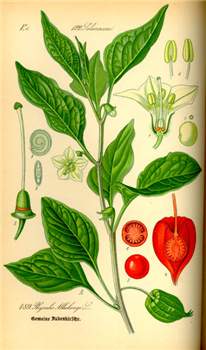
Taxonomy
Physalis L., Sp. Pl. 1: 182 (1753), & Gen. Pl. 5th edn, 85 (1754); from the Greek physallis (bladder), in reference to the inflated fruiting calyx.
Type species: P. alkekengi L.
Summer-growing annuals, rhizomatous perennials or short-lived shrubs, glabrous or pubescent with simple, forked or glandular hairs. Leaves alternate, 1 or 2 per node (but not opposite), when 2 unequal in size, simple, entire, toothed or lobed, petiolate. Flowers solitary in leaf axils and stem forks, bisexual, actinomorphic. Calyx tubular to campanulate, 5–lobed, enlarged in fruit. Corolla broadly campanulate to rotate, mostly yellow, often with dark spots towards the base; tube short; limb expanded, shallowly 5–lobed, folded in bud. Stamens 5, equal or unequal in height, inserted towards base of corolla-tube; anthers bilocular, basifixed, dehiscing by longitudinal slits. Ovary bilocular; stigma capitate. Fruit a berry enclosed by inflated calyx. Seeds disc-shaped to broadly reniform.
A widespread genus of c. 100 species, most common in North and South America but with some species occurring naturally in temperate and tropical Asia. Several species with edible berries are cultivated for their fruit. One species (P. minima L.) possibly endemic to Australia; seven species introduced and naturalised to varying degrees as weeds of waste and cultivated ground. Naturalisation was early since a Physalis species is depicted in John Lewin's 1803-1808 depictions of the Sydney flora - see http://image.sl.nsw.gov.au/cgi-bin/ebindshow.pl?doc=pxc304/a633;seq=150 as well as the Cape gooseberry - see http://image.sl.nsw.gov.au/cgi-bin/ebindshow.pl?doc=pxc304/a633;seq=167
U.T. Waterfall, A taxonomic study of the genus Physalis in North America north of Mexico, Rhodora 60: 107–114, 128–142, 152–173 (1958); U.T. Waterfall, Physalis in Mexico, Central America and the West Indies, Rhodora 69: 82–120, 202–239, 319–329 (1967); R.B. Fernandes, Sur l'identification d'une espéce de Physalis souspontanée au Portugal, Bol. Soc. Brot. 44: 343–366 (1970); D.E. Symon, The solanaceous genera, Browallia, Capsicum, Cestrum, Cyphomandra, Hyoscyamus, Lycopersicon, Nierembergia, Physalis, Petunia, Salpichroa and Withania, naturalised in Australia, J. Adelaide Bot. Gard. 3: 133–166 (1981).
Changes since the Flora of Australia treatment
This group remains a difficult one. See under the Key to species below for changes which have occurred since the Flora of Australia treatment.
A table of comparison of species in California can be found on the California Department of Food and Agriculture site at http://www.cdfa.ca.gov/phpps/ipc/weedinfo/physalis-table.htm This table covers most of the species found in Australia.
Another publication since the Flora of Australia treatment which considers hair morphology in relation to classification is Seithe, A. & Sullivan, J.R. (1990). Hair morphology and systematics of Physalis (Solanaceae). Plant Systematics and Evolution 170: 193–204.
A labelled longitudinal section of a flower of Physalis can be seen at http://www.life.uiuc.edu/help/digitalflowers/Solanaceae/21.htm
Key to species
Since this key was prepared there have been some changes. P. minima of the earlier flora is now treated as P. angulata and a further species, P. micrantha, has been recorded from the Northern Territory by Symon (D.E.Symon (1997). Physalis micrantha (Solanaceae) recorded from the Northern Territory. Australian Systematic Botany 10: 681-2).
More recently Tony Bean has published a new key to the species in Australian Systematic Botany Society Newsletter 127 (2006). This work primarily stemmed from work on the genus in southeastern United States by Sullivan (J.R.Sullivan (2004). The genus Physalis (Solanaceae) in the southeastern United States. Rhodora 106: 305-26). As a result of his study of Queensland Herbarium specimens Bean considers P. virginiana should be treated as P. longifolia and P. micrantha described by Symon should be treated as P. minima.
The genus remains difficult and it is likely that there will be further changes as further revisional and DNA studies of these weedy introduced species are carried out. The key below is the original from the Flora with some updating: Bean's key to the species can be accessed through the link given above.
1 Herbaceous perennials with rhizomatous rootstock; indumentum of simple or forked non-glandular hairs, or glabrescent
2 Corolla dull white, limb distinctly 5–lobed; fruiting calyx orange or red
Physalis alkekengi
2: Corolla yellow, limb entire or scarcely lobed; fruiting calyx green or yellow
3 Tomentum including some minute forked hairs; leaves ovate-lanceolate, usually toothed or sinuate
Physalis viscosa
3: Tomentum of simple hairs only; leaves elliptic, entire or with a few indistinct lobes
Physalis virginiana (or P. longifolia according to Bean 2006)
1: Annuals or short-lived perennials; indumentum sparse to dense, of glandular or simple (never forked) non-glandular hairs
4 Plants obviously pubescent, hirsute or pilose with erect, glandular or simple non-glandular hairs; corolla conspicuously spotted
5 Annuals; corolla 7–11 mm long; anthers 1.5–2 mm long; fruiting calyx 5–angled
Physalis pubescens
5: Soft-wooded short-lived perennials; corolla 10–15 mm long; anthers 4–5 mm long; fruiting calyx 10–angled
Physalis peruviana
4: Plants sparsely pubescent with erect or appressed, simple, non-glandular hairs, or becoming glabrescent; corolla marked with inconspicuous blotches
6 Anthers 3–4 mm long, becoming twisted; flowers bright yellow; berries mostly 17–30 mm diam.
Physalis philadelphica
6: Anthers 2–2.5 mm long, straight; flowers dull yellow; berries usually 8–15 mm diam.
7 Leaves narrowly elliptic; pedicels usually 20–30 mm long
Physalis lanceifolia
7: Leaves ovate-lanceolate; pedicels usually 5–25 mm long;
8 Pedicel 5–10 mm long; style 2–2.5 mm long; fruiting calyx circular in section
Physalis ixocarpa
8: Pedicel usually 20–25 mm long; style 4–5 mm long; fruiting calyx angular in section
Physalis minima (now P. angulata)


